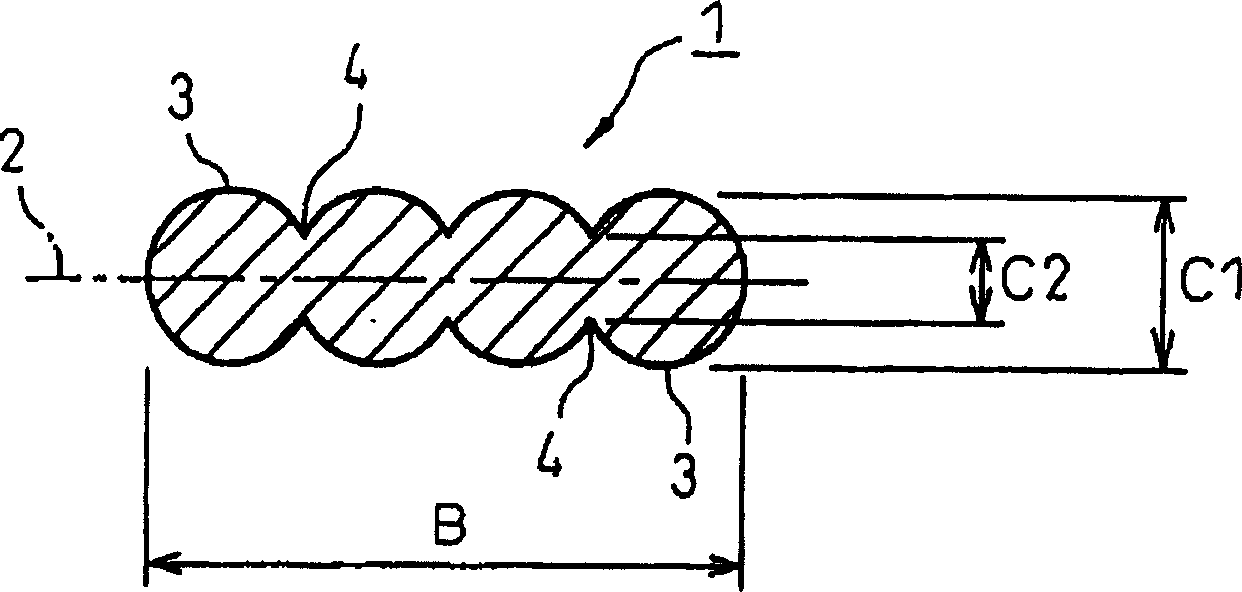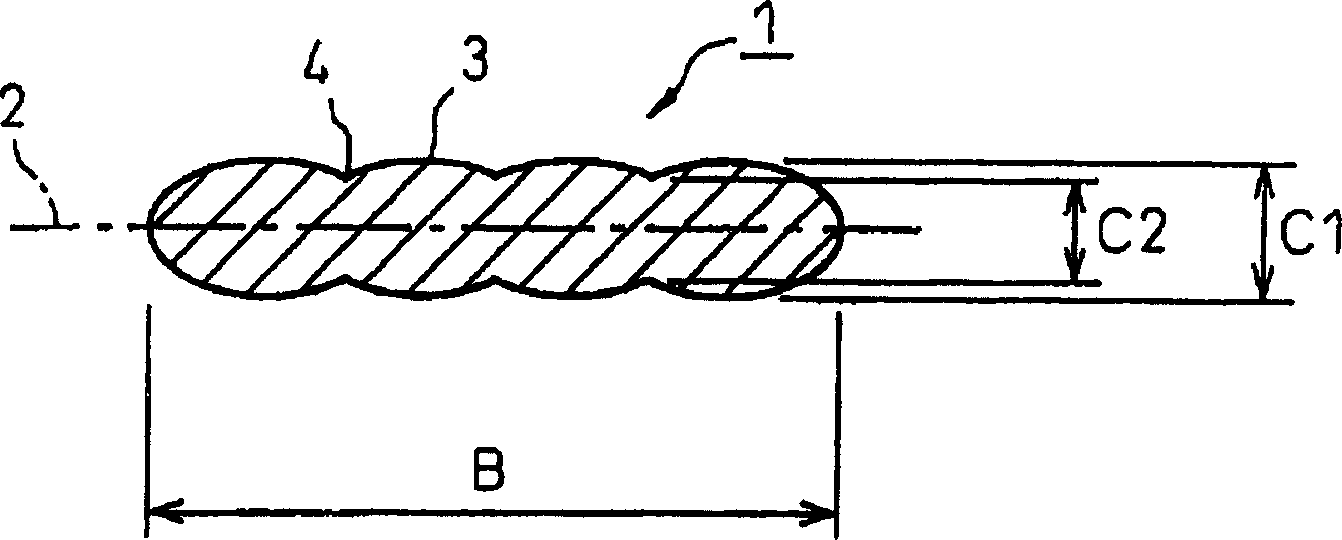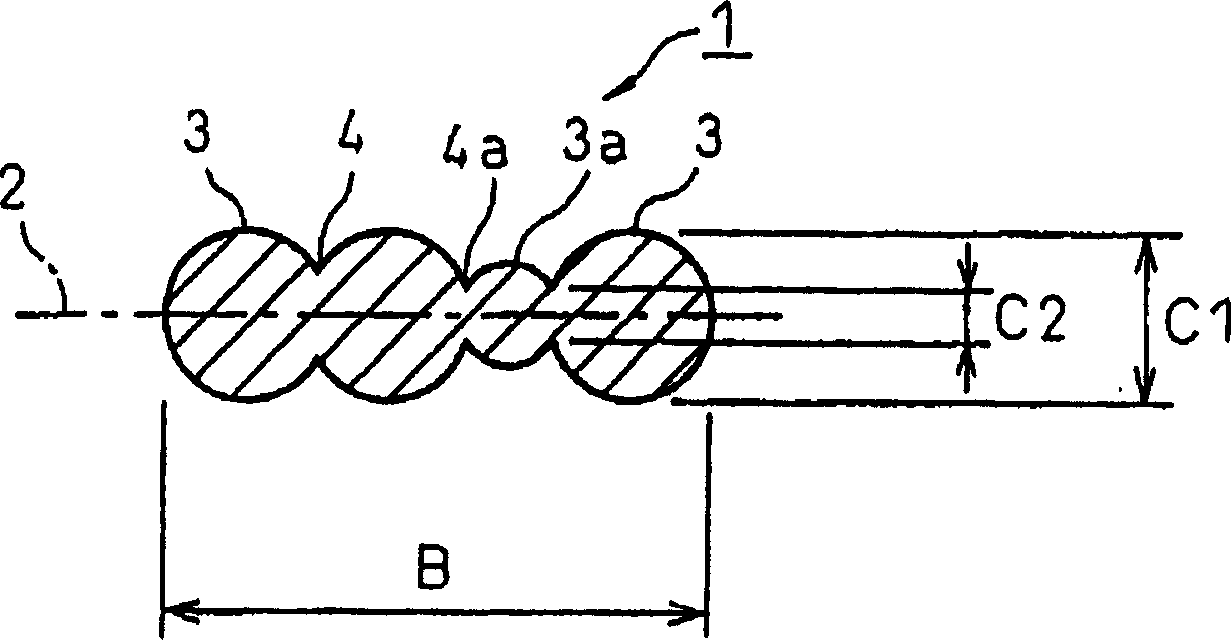Flat multifilament-yarn textile
A technology of multifilament yarn and weaving fabrics, which is applied in the field of weaving fabrics and can solve problems such as unfavorable and poor sweat absorption
- Summary
- Abstract
- Description
- Claims
- Application Information
AI Technical Summary
Problems solved by technology
Method used
Image
Examples
example 1
[0116] Polyethylene terephthalate resin is formed by melt-extrusion through 30 melt spinning holes at a temperature of 300°C. These holes are formed in the melt spinneret and have corresponding figure 1 The hole shape of the cross-sectional profile of the wire shown, on each side part of the profile, the profile has 4 arc-shaped protrusions and 3 constrictions formed between the arc-shaped protrusions, which are formed in the shape of the On both sides of the longitudinal centerline. The extruded filament melt stream is wound up at a winding speed of 4000 m / min, while the melt stream is cooled and solidified. The finally formed stretched multifilament yarn was directly stretched at a temperature of 97°C at a draw ratio of 1.3 without being wound, thereby preparing a stretched multifilament yarn having a yarn count of 84 dt / 30 filaments. The monofilament of multifilament has figure 1 In the cross-sectional profile shown, the flatness of the cross-sectional profile is 3.2, and the...
example 2
[0145] With the exceptions shown below, the plain weave of the flat multifilament was produced and tested by the same procedure as in Example 1.
[0146] In the cross-sectional profile of the flat monofilament, the number of arc-shaped protrusions was changed from 4 to 3, and the number of constrictions was changed from 3 to 2 at each side portion of the longitudinal center line of the flat profile.
[0147] The flatness (B / C1) of the flat cross-sectional shape is 3.2, the ratio (C1 / C2) is 1.2, and the cover factor of the plain weave is 1782.
[0148] The test results are shown in Table 1.
example 3
[0164] The polyethylene terephthalate resin containing 2.5% by mass of a delustering agent composed of titanium dioxide is formed by melt-extrusion through 30 melt spinning holes at a temperature of 300°C, and these holes are formed in the melt spinning Head and has corresponding to figure 1 The hole shape of the cross-sectional profile of the wire shown, on each side part of the profile, the profile has 4 arc-shaped protrusions and 3 constrictions formed between the arc-shaped protrusions, which are formed in the shape of the On both sides of the longitudinal centerline. While condensing and solidifying the melt stream, the extruded filament melt stream is wound up at a winding speed of 4000 m / min. The finally formed drawn multifilament was drawn directly without being wound at a temperature of 97°C at a draw ratio of 1.3, thereby preparing drawn multifilament with a yarn count of 84dt / 30 filaments. The monofilament of multifilament has figure 1 In the cross-sectional profile s...
PUM
| Property | Measurement | Unit |
|---|---|---|
| transmittivity | aaaaa | aaaaa |
| cover factor | aaaaa | aaaaa |
| transmittivity | aaaaa | aaaaa |
Abstract
Description
Claims
Application Information
 Login to View More
Login to View More - R&D
- Intellectual Property
- Life Sciences
- Materials
- Tech Scout
- Unparalleled Data Quality
- Higher Quality Content
- 60% Fewer Hallucinations
Browse by: Latest US Patents, China's latest patents, Technical Efficacy Thesaurus, Application Domain, Technology Topic, Popular Technical Reports.
© 2025 PatSnap. All rights reserved.Legal|Privacy policy|Modern Slavery Act Transparency Statement|Sitemap|About US| Contact US: help@patsnap.com



